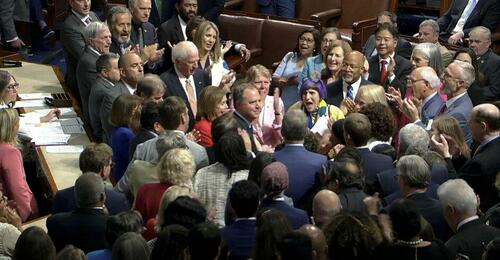Germany’s Outgoing Economy Minister Warns Europe Not To Over-Rely On US Energy
Authored by Tom Ozimek via The Epoch Times,
Europe must avoid becoming too dependent on U.S. energy supplies, Germany’s outgoing economy minister Robert Habeck cautioned on Jan. 21, which comes amid President Donald Trump’s demands that the European Union (EU) buy enough American oil and gas to make up for the U.S. trade deficit with the EU – or face tariffs.
Habeck, a member of Germany’s Green Party, said at the Handelsblatt energy summit in Berlin on Jan. 21 that relying too much on U.S. energy supplies risks repeating the same type of “blackmail that we had in Russia.”
Europe’s high degree of reliance on Russian energy constrained the region’s ability to respond to Russia’s invasion of Ukraine with forceful sanctions like cutting energy ties entirely to starve Moscow of revenues, which have bolstered the Kremlin’s war chest.
Habeck urged Europe to “meet the Trump administration with an outstretched hand, but not have our hand cut off,” adding that the EU should define its own interests rather than submit to America’s direction.
It comes as Trump recently threatened to impose tariffs on European countries unless they buy large enough quantities of U.S. energy to make up for the EU’s trade gap with the United States, which in 2023, stood at around $57 billion in favor of the EU.
“I told the European Union that they must make up their tremendous deficit with the United States by the large-scale purchase of our oil and gas. Otherwise, it is tariffs all the way,” Trump wrote in a Dec. 20 post on Truth Social.
European Commission spokesperson Olof Gill told The Epoch Times in response to an inquiry about Trump’s tariff threat that the bloc is prepared to hold discussions with the Trump administration on how to address its concerns.
“The EU and U.S. have deeply integrated economies, with overall balanced trade and investment. We are ready to discuss with President-elect Trump how we can further strengthen an already strong relationship, including by discussing our common interests in the energy sector,” Gill told The Epoch Times in an emailed statement.
Trump has long been a critic of America’s trade deficits with other countries and an advocate of using tariffs as a negotiating tool to achieve various policy aims. One of these objectives is for Europe to import more energy from the United States, which would both add to America’s wealth and help European nations bolster their security with a NATO ally by further reducing reliance on Russian imports.
While the EU has dramatically decreased its reliance on Russian energy since the outbreak of the war in Ukraine, the bloc continues to import significant quantities of Russian natural gas. In fact, Europe imported a record 16.5 million metric tons of liquefied natural gas (LNG) from Russia in 2024, exceeding the prior record of 15.2 million that it imported in 2022. This comes despite the EU’s pledge to cut all energy deals with Russia by 2027.
European officials have acknowledged they need to do more to wean the bloc off Russian energy. European Commission spokesperson Anna-Kaisa Itkonen told reporters in Brussels on Jan. 20 that, despite lack of progress in some areas, the EU is determined to cut all energy ties with Russia and is finalizing a plan to accomplish this aim.
“We cut all Russian coal imports, most Russian oil imports, and over two thirds of Russian gas,” Itkonen said. “Despite these significant results, there is still presence of Russian gas on the EU market. And this is something that we’d rather not see.”
Top EU officials have indicated their intention to increase purchases of American energy. Ursula von der Leyen, president of the European Commission, said in November that LNG imports from the United States could replace the bloc’s remaining imports of Russian LNG.
“We still get a whole lot of LNG via Russia, from Russia,” von der Leyen told reporters at a summit in Budapest, Hungary, on Nov. 8. “And why not replace it with American LNG, which is cheaper, and brings down our energy prices.”
Meanwhile, in a bid to bolster domestic U.S. energy production—which would increase its availability for export to allies—Trump on Jan. 20 signed an executive order lifting former President Joe Biden’s freeze on LNG export permitting, as well as other orders promoting oil and gas exploration in Alaska, and reversing Biden’s actions aimed at protecting Arctic lands and coastal waters from drilling.
Tyler Durden
Thu, 01/23/2025 – 06:30
via ZeroHedge News https://ift.tt/VxpUvX6 Tyler Durden











